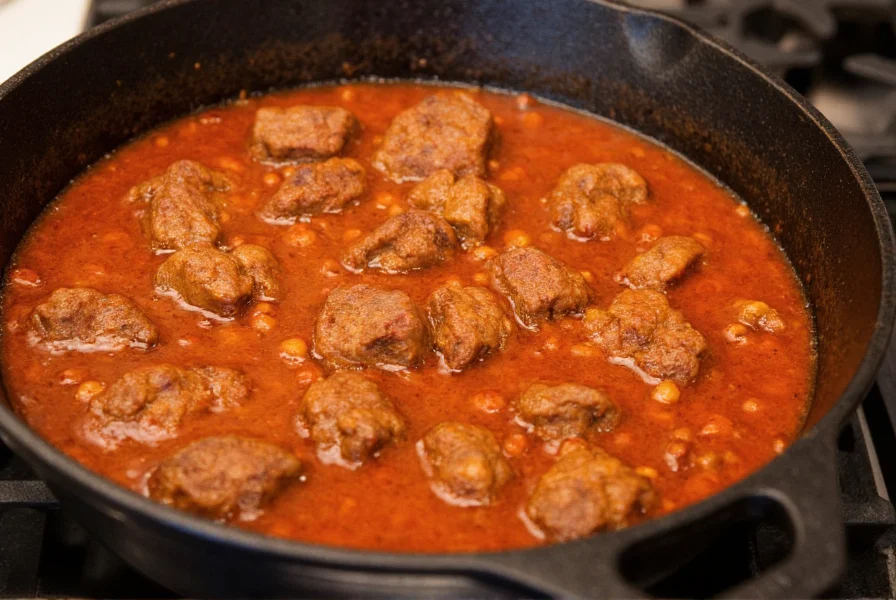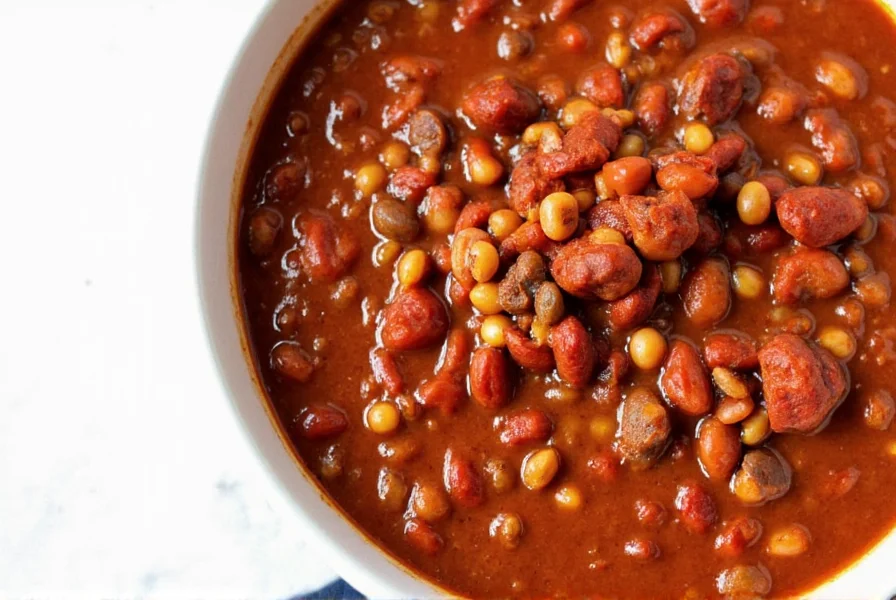For generations, Texans have fiercely defended their chili tradition: no beans allowed. This isn't just culinary preference—it's cultural identity. Authentic Texas chili represents the state's cowboy heritage, where cowhands cooked meat with available spices over open fires during cattle drives. Understanding this history explains why beans have no place in true Texas-style chili.
The Origins of Beanless Texas Chili
Chili's journey to Texas began with Indigenous peoples in the Americas who combined meat with native chili peppers. Spanish colonists later adopted and modified these recipes. By the 1800s, Texas cowboys perfected the dish using ingredients they could carry on cattle drives: dried beef, animal fat, and dried chili peppers.
Beans entered American chili culture through different regional traditions, particularly in Northern Mexico and the Southwestern United States. However, traditional Texas chili connoisseurs maintained the beanless approach, viewing beans as filler that dilutes the meat's flavor—a perspective formalized when the 1977 Texas Legislature declared chili the official state dish with the stipulation that "chili means chili con carne, and chili con carne means 'chili with meat.'"
Why Texas Chili Contains No Beans: Cultural Significance
The exclusion of beans in authentic Texas chili isn't arbitrary—it's deeply rooted in regional identity. During the Great Depression, many families added beans to stretch meat portions, creating regional variations. But Texas chili purists maintained the original recipe as a point of pride.
Modern Texas chili competitions, including the prestigious Terlingua International Chili Championship, strictly prohibit beans in their traditional categories. Judges evaluate entries based on meat quality, spice balance, and texture—none of which beans enhance according to traditional standards.
| Traditional Texas Chili Ingredients | Modern Variations (Non-Traditional) |
|---|---|
| Beef (chuck, brisket, or round) | Beans (kidney, pinto) |
| Dried chili peppers (ancho, guajillo) | Canned tomatoes |
| Beef suet or animal fat | Worcestershire sauce |
| Cumin, garlic, oregano | Chocolate or coffee |
| Beef broth or water | Beer or wine |
Authentic Texas No Bean Chili Recipe
Creating genuine Texas chili requires patience and respect for tradition. This recipe serves 6-8 and takes approximately 3-4 hours, including preparation and slow cooking.

Ingredients
- 3 lbs beef chuck, cut into 1/2-inch cubes
- 4 oz beef suet or substitute with vegetable shortening
- 4 dried ancho chili peppers
- 3 dried guajillo chili peppers
- 2 dried pasilla chili peppers
- 6 cloves garlic, minced
- 2 tbsp ground cumin
- 1 tbsp dried oregano
- 2 tsp black pepper
- 1 tsp cayenne pepper (optional for heat)
- 4 cups beef broth
- Salt to taste
Preparation Steps
- Prepare chili peppers: Remove stems and seeds from dried peppers. Toast lightly in dry skillet for 30 seconds per side until fragrant but not burnt. Soak in hot water for 20 minutes until soft.
- Create chili paste: Blend soaked peppers with 1 cup beef broth until smooth. Strain through fine mesh sieve to remove skins.
- Sear meat: Heat suet in heavy pot over medium-high heat. Brown beef in batches, avoiding overcrowding.
- Build flavor base: Add garlic to pot and cook until fragrant (about 1 minute). Return all meat to pot.
- Combine ingredients: Add chili paste, cumin, oregano, black pepper, and remaining broth. Stir well.
- Slow cook: Simmer uncovered for 2.5-3 hours, stirring occasionally, until meat is tender and sauce has thickened.
- Season: Add salt to taste. Authentic Texas chili should have a thick, gravy-like consistency that coats the back of a spoon.
Mastering Texas Chili Technique
The secret to exceptional Texas no bean chili lies in technique rather than additional ingredients. Traditional cooks emphasize three critical elements:
Meat selection matters most. Choose well-marbled beef chuck or brisket—the fat content creates richness without needing beans for texture. Some traditionalists even add beef suet for authentic flavor and mouthfeel.
Chili pepper quality is non-negotiable. Freshly ground dried peppers provide depth that canned alternatives cannot match. Many Texans visit specialty markets to select peppers by aroma and appearance.
Time transforms texture. Authentic Texas chili requires slow cooking to break down connective tissues in the meat, creating natural thickness. Rushing the process with thickeners violates tradition.
Serving Texas Chili Authentically
In Texas, chili appears in three primary contexts:
- As a standalone dish: Served in bowls with crackers or cornbread on the side—never with rice or pasta
- As chili con carne: Topped with shredded cheese, raw onion, and oyster crackers
- As a topping: For hot dogs ("chili dogs") or on tamales ("chili-topped tamales")
Texans traditionally avoid garnishes that distract from the chili's pure flavor profile. While northern regions might add sour cream or avocado, these toppings remain controversial in authentic Texas settings.
Common Mistakes in Making Texas No Bean Chili
Even experienced cooks make these errors when attempting authentic Texas chili:
- Using ground beef: Traditional Texas chili features cubed meat, not ground
- Adding tomatoes: While common elsewhere, tomatoes aren't part of authentic Texas recipes
- Over-spicing: Cumin should complement, not dominate, the chili pepper flavors
- Rushing the cooking process: True Texas chili requires hours of slow simmering
- Thickening with flour: Authentic texture comes from reduced broth and meat collagen
Modern Interpretations While Honoring Tradition
While purists maintain strict bean-free standards, some contemporary chefs create respectful variations that maintain Texas chili's essence:
- Adding a small amount of espresso to deepen flavor (without making it sweet)
- Using different meat combinations like venison with beef
- Experimenting with heirloom chili varieties while maintaining traditional ratios
- Adjusting heat levels for different palates while preserving flavor complexity
The key is enhancing rather than altering the fundamental character of Texas chili. Even modern interpretations typically honor the no-bean principle as a nod to tradition.
Frequently Asked Questions
Why is there no beans in Texas chili?
Texas chili traditionally contains no beans because the dish originated with Texas cowboys who cooked meat with available spices during cattle drives. Beans weren't part of their provisions. The 1977 Texas Legislature officially recognized chili as the state dish with the understanding that "chili means chili con carne"—chili with meat. Beans were viewed as filler that dilutes the meat's flavor, which contradicts Texas chili's meat-centric philosophy.
What gives Texas chili its distinctive flavor?
Authentic Texas chili gets its distinctive flavor from a combination of dried chili peppers (typically ancho, guajillo, and pasilla), beef suet or animal fat, and slow cooking that develops deep meat flavors. The absence of beans, tomatoes, or other fillers allows the complex spice profile and rich meat flavor to dominate. Properly prepared Texas chili has a thick, gravy-like consistency achieved through reduction rather than thickeners.
Can I make Texas chili without dried chili peppers?
While possible to substitute with chili powder, authentic Texas chili requires dried chili peppers for proper flavor. The toasting and soaking process develops nuanced flavors that pre-ground spices cannot replicate. If dried peppers are unavailable, look for high-quality ancho chili powder as the closest alternative, but understand this creates a different product than traditional Texas chili. Many Texans consider dried peppers non-negotiable for authentic preparation.
How long should Texas chili simmer for best results?
Authentic Texas chili requires 2.5-3 hours of gentle simmering after the initial preparation. This extended cooking time allows connective tissues in the meat to break down, creating natural thickness and melding flavors. Rushing the process produces inferior texture and flavor development. Some traditionalists even cook chili for 4-6 hours, occasionally adding small amounts of broth to maintain proper consistency throughout the cooking process.
What's the difference between Texas chili and Cincinnati chili?
Texas chili is a thick, beanless meat stew focused on beef and chili pepper flavors, typically served as a main dish. Cincinnati chili features Mediterranean spices like cinnamon and allspice, has a thinner consistency, always includes tomatoes, and is served as a topping for spaghetti with specific cheese combinations ("3-way," "4-way," "5-way"). While both are regional specialties, they represent completely different culinary traditions with distinct flavor profiles and serving styles.











 浙公网安备
33010002000092号
浙公网安备
33010002000092号 浙B2-20120091-4
浙B2-20120091-4